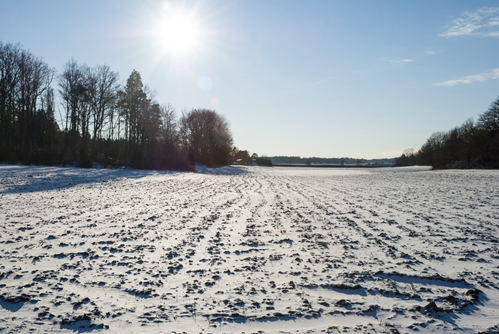The weather is growing colder – albeit a little slower than normal – which means it is time to start undergoing preparations for winter. Here is what you need to know to prepare your pasture for spring and keep your horse warm and healthy during the winter months:
“Keep ash, sand, salt or nonclumping clay cat litter to give icy walkways traction.”
Stockpiling supplies
If you live under the threat of a sudden winter storm, grab some extra feed, hay and equine supplements. This way, you don’t have to worry about running out if you end up snowed in. You should also keep essential snow supplies on hand, including ash, sand, salt or non-clumping clay cat litter to give icy walkways traction. Salt is best for melting ice, but you’ll want to keep it out of grassy areas because it kills plants and burns skin. Even though sand and ash melt ice slowly and are harder to control, accidentally tracking them into your horse’s enclosure won’t cause harm.
Finally, check any medications or equine supplements your horse takes. As Equus Magazine notes, some drugs become ineffective if exposed to cold weather. This is also a good time to check expiration dates and, if necessary, get a new prescription from your veterinarian.
Deciding to use a blanket
When it comes to weathering the cold, horses are a lot tougher than humans. In fact, according to HorseChannel, many can stand the outdoors until temperatures drop below 0 degrees Fahrenheit. Still, you can give your horse a blanket to keep it warm if you choose, especially if it’s elderly or has a thin coat. Just be certain to take the blanket off every day to check for rub marks. Remove it or replace it with a lighter one if your horse starts sweating. If you don’t, the moisture will cool once in contact with cold air and cause your horse to shiver. Otherwise, once the moisture comes in contact with the cold air, it will cool and cause your horse to shiver.
In addition, before blanketing your horse, inspect the material for mold, bugs, holes, torn seams or bite marks from rodents. Any small tear will allow cold air to get in. If you plan to exercise your horse, trimming its coat helps prevent it from getting hot and sweaty. Only clip the area that would be covered by a blanket, and keep your horse blanketed when not training.
Feeding for warmth
Horses burn more calories in winter to keep warm and must be fed accordingly. Instead of supplying more food with each feeding, however, give your horse hay more frequently throughout the day. A horse’s stomach is designed to have some food in it at all times, and a consistently empty stomach increases the risk of colic.
“Check your horse’s salt block each time you fill its water bucket.”
If you live in a place with regular freezing temperatures, check your horse’s salt block each time you fill its water bucket. These blocks can get so cold that your equine’s tongue will stick to it. Depending on the temperature, you might be better off adding loose salt to your horse’s grain, HorseChannel notes.
Checking the barn and equipment
You might be tempted to stave off the cold by sealing your barn or stable’s every nook and cranny, but this makes for poor ventilation and sets the stage for dust buildup. On the other hand, too much airflow drops the inside temperature to uncomfortable levels. Equus Magazine recommends holding a light tissue up in different areas. It should sway gently, indicating a good flow of air. If it stays still or forcefully waves back and forth, open or close windows as necessary.
Prepping the pasture
Giving your horse free access to all areas of the pasture ends up doing more harm than good. The grass here needs time to rest so it can regrow properly in the spring. Without this downtime, your pasture will be filled with weeds and bare patches from overgrazing and the equine’s own footsteps. As horses walk across the frozen ground, their hooves create divots that ruin the root systems of the grass underneath. They also compress the soil so water can’t run through, TheHorse.com mentions. Keep your equine in a sacrifice area during the winter so your pasture can recuperate.
Make sure to mow your pasture before the first snow fall so long grass and weeds don’t get stuck underneath. Getting rid of weeds beforehand also stops them from being a problem in spring. Leave a few inches of grass – Equus Magazine suggested no fewer than four – so the roots can last throughout the snow.
Such drastic measures are not needed if you live in a warmer climate. In fact, you might want to let the grass grow a little thicker during late summer and fall so your horse can graze happily throughout the winter.








